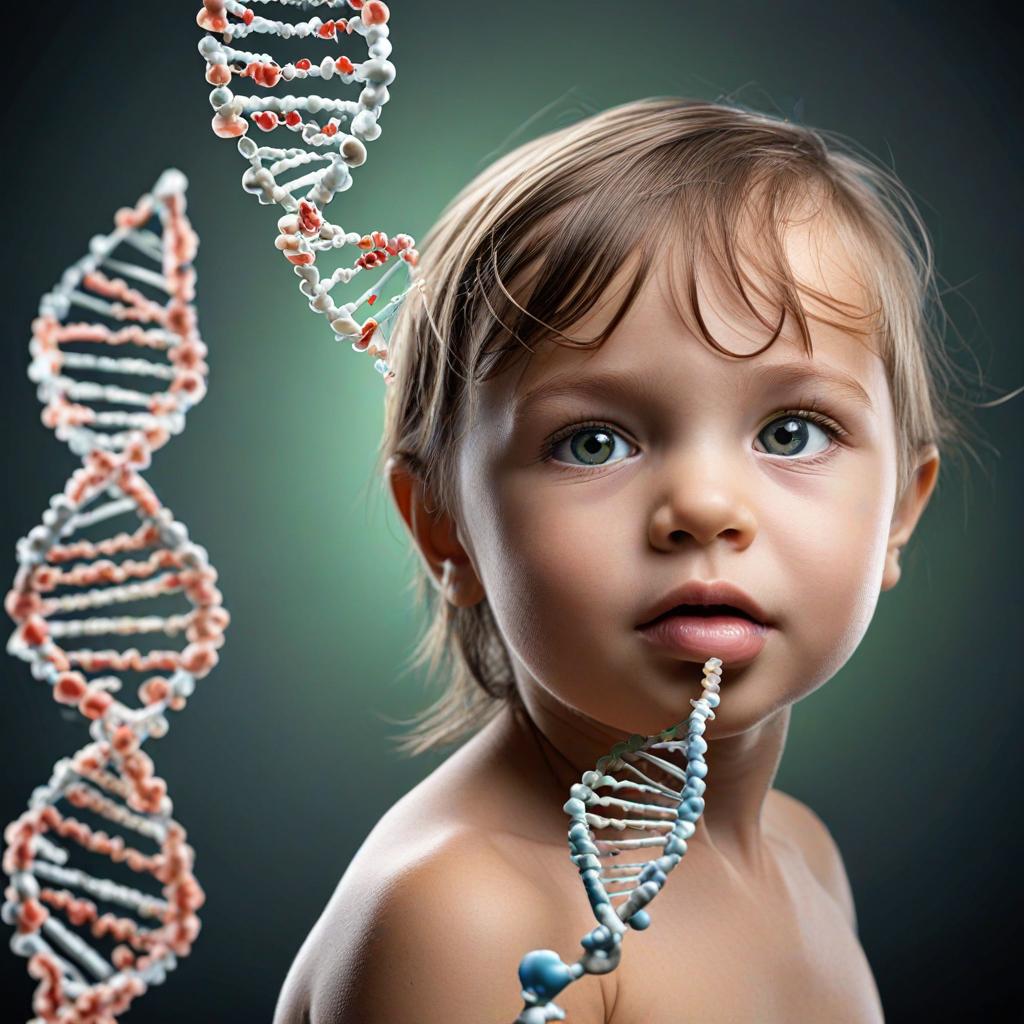Exploring Genetic Engineering, Epigenetics, and the Role of Conscious Gene Control in Reversing Age, Curing Genetic Diseases, and Understanding the Impact of Technology
Genetic engineering has revolutionized our understanding of biology, allowing humanity to manipulate genes in ways once thought impossible. The interplay between genes, environment, and conscious decision-making offers groundbreaking insights into our mental and physical health. By understanding genetic influence, we can address aging, cure genetic diseases, and modify gene expression. Let’s explore how modern technologies like CRISPR, AI/ML, quantum computing, and blockchain are accelerating these developments.
1. Genetic Engineering and Epigenetics: The Blueprint of Life
At its core, genetic engineering involves directly modifying an organism’s DNA, the code that defines biological function. Epigenetics, on the other hand, is the study of changes in gene expression caused by external or environmental factors without altering the DNA sequence. Genes are not static blueprints; they can be activated or deactivated by factors such as diet, stress, and environmental conditions. Epigenetic changes can be inherited or reversed, offering the potential to ‘turn on or off’ genes that influence health and disease.
This gene expression plays a crucial role in aging, disease development, and mental health. The idea that we might one day reverse age or switch off genes responsible for genetic disorders is no longer science fiction. Technologies like CRISPR (Clustered Regularly Interspaced Short Palindromic Repeats) allow precise editing of the genome, correcting mutations or even adding new genetic information to counteract the effects of aging and disease.
2. The Role of CRISPR and Advanced Technologies in Genetic Engineering
CRISPR has emerged as a leading tool in genetic modification, enabling scientists to target and edit specific genes with unprecedented precision. Its potential applications range from curing genetic diseases like cystic fibrosis and sickle cell anemia to enhancing human longevity by turning off aging-related genes.
However, the real revolution is the integration of Artificial Intelligence (AI) and Machine Learning (ML) in genomics. AI is helping researchers analyze vast genetic datasets to identify patterns, predict mutations, and understand gene-environment interactions. This leads to more personalized treatments based on an individual’s genetic makeup, often referred to as “precision medicine.” ML models can predict how changes to specific genes will affect cell behavior, making gene therapy more effective.
Quantum computing promises to take genetic research to the next level by solving complex biological problems faster than classical computers. With its ability to process massive amounts of data simultaneously, quantum computing could decode the mysteries of DNA at an atomic level, unraveling how genes influence behavior, health, and lifespan.
Blockchain technology, while mostly associated with cryptocurrencies, could offer a secure way to store and share sensitive genetic data, ensuring privacy and enhancing collaboration among researchers worldwide.
3. Understanding the Gene-Environment Interaction
Genes do not operate in isolation. Their expression is influenced by environmental factors, which can include everything from diet and pollutants to stress and social interactions. Epigenetic mechanisms like DNA methylation and histone modification act as “switches” that control whether certain genes are expressed. These changes can be temporary or long-lasting, and they often occur subconsciously in response to environmental stimuli.
For example, prolonged stress can trigger the expression of genes associated with anxiety and depression. Likewise, poor dietary choices can activate genes linked to obesity and diabetes. This gene-environment interaction is at the heart of many chronic diseases and psychological conditions. Often, our subconscious reactions to environmental stressors activate genes in ways we are unaware of, contributing to harmful health outcomes.
4. Why Do Genes Act Compulsively in Certain Situations?
Even when we consciously know how we should behave, our genes can sometimes compel us to act in ways that contradict rational decision-making. This is particularly true for behaviors driven by deeply ingrained evolutionary instincts, such as fear, aggression, or the fight-or-flight response. These compulsive reactions are often the result of a mismatch between our modern environment and the genetic programming inherited from our ancestors, whose survival depended on quick, instinctive reactions to immediate threats.
In the brain, this is orchestrated by the limbic system, which includes structures like the amygdala (responsible for emotional reactions) and the hippocampus (involved in memory formation). When confronted with stress or danger, the brain triggers a cascade of signals that activate stress-related genes. This “fight-or-flight” response is hardwired for survival, but in modern society, it can lead to overreactions, anxiety, or chronic stress.
Additionally, dopamine pathways in the brain play a significant role in compulsive behavior. Genes that regulate dopamine levels are crucial for reward-seeking behavior and can lead to addiction, impulsive actions, or irrational decisions, especially under stress.
5. How Science is Working Toward Solutions
The goal of modern genetics is not just to understand these subconscious reactions but to find ways to modulate or control them. By identifying the genes responsible for certain behaviors or diseases, we can develop therapies to alter their expression.
- Gene Therapy: Advances in CRISPR technology could allow us to switch off genes that trigger undesirable behaviors or conditions. For instance, turning off a gene that increases susceptibility to anxiety or depression could provide relief to millions of people.
- Neuroplasticity and Behavioral Interventions: The brain’s ability to reorganize itself by forming new neural connections (neuroplasticity) also offers hope. Through behavioral therapies and conscious effort, individuals can “retrain” their brains to override genetic predispositions, a process often augmented by medications that influence gene expression.
- Epigenetic Drugs: Scientists are developing epigenetic drugs that can modify the chemical markers controlling gene expression, offering treatments for diseases like cancer, Alzheimer’s, and mental health disorders by turning harmful genes off or activating protective ones.
6. Ethical Considerations and the Future
While the potential of genetic engineering and epigenetics is staggering, it raises important ethical questions. Should we alter genes to enhance human abilities or simply focus on curing diseases? Where should we draw the line between treatment and enhancement?
The future of genetic engineering will likely involve more sophisticated tools that give individuals some degree of conscious control over their genetic makeup. This could lead to a world where we not only cure genetic diseases but also enhance physical and cognitive abilities, reverse aging, and even choose the traits we pass on to future generations.
8. The Fundamentals of DNA and Genes
At the most basic level, our genetic information is stored in DNA, a molecule composed of four nucleotide bases (adenine, thymine, cytosine, and guanine). These bases are arranged in specific sequences, forming genes that serve as instructions for producing proteins—the building blocks of life. Understanding the structure of DNA and the function of genes is essential for genetic engineering, as it allows us to identify which genes are responsible for specific traits or diseases.
- Genes and Protein Synthesis: Genes encode for proteins through a two-step process: transcription and translation. In transcription, DNA is transcribed into messenger RNA (mRNA), which is then translated into a protein. Manipulating genes at either the transcriptional or translational level can alter protein production, impacting cell function and overall health.
9. From Genetic Mutations to Gene Editing
Mutations are changes in DNA that can occur naturally or due to external factors like radiation or chemicals. Some mutations are harmless, while others lead to genetic disorders. Gene editing tools like CRISPR allow us to correct these mutations by precisely altering the DNA sequence.
- Somatic vs. Germline Editing: Somatic gene editing targets non-reproductive cells and is used to treat diseases in individuals without passing the genetic modifications to offspring. Germline editing, on the other hand, involves changes to reproductive cells, meaning the edited genes are passed on to future generations. Germline editing raises complex ethical concerns about its long-term impact on humanity.
10. RNA-Based Therapies
Beyond DNA, RNA has emerged as a critical target in genetic medicine. RNA interference (RNAi) and messenger RNA (mRNA) therapies can be used to silence harmful genes or introduce new proteins into cells.
- mRNA Vaccines: The success of mRNA vaccines in combating COVID-19 has opened the door for RNA-based therapies to treat a variety of genetic and infectious diseases. These vaccines work by instructing cells to produce specific proteins that trigger an immune response, showcasing the potential of RNA to modulate genetic function.
11. Gene Silencing and Activation Techniques
Modern biotechnology has developed techniques to either silence (inhibit) or activate specific genes. One of these techniques is antisense therapy, where short strands of DNA or RNA are used to bind to specific mRNA sequences, preventing them from producing harmful proteins. Zinc Finger Nucleases (ZFNs) and TALENs are other tools for gene targeting, often used when precision editing like CRISPR isn’t applicable.
- Gene Knockouts and Knock-ins: Scientists can “knock out” genes to study their functions or “knock in” beneficial genes to replace defective ones. This technique is widely used in research to model diseases in animals and test treatments before they are used in humans.
12. Epigenetic Inheritance and Environmental Influence
One of the most intriguing aspects of epigenetics is that certain environmental influences can cause changes in gene expression that are passed down to future generations without altering the DNA sequence. This is known as epigenetic inheritance. Factors like diet, stress, and toxins can cause these heritable changes, affecting not just the individual but potentially their descendants.
- Maternal and Paternal Influence: Research shows that both maternal and paternal environments (such as nutrition, stress, and exposure to toxins) can influence the epigenome of offspring. For example, studies have shown that the diet of a pregnant mother can affect her child’s risk of obesity or diabetes through epigenetic changes.
13. Systems Biology: Understanding the Gene Network
Genes rarely act in isolation; they are part of vast networks that interact in complex ways. Systems biology is the study of these networks, combining biology, computer science, and mathematics to model how genes, proteins, and other molecules interact within cells.
- Gene Regulatory Networks (GRNs): GRNs are complex webs of genes that regulate each other’s expression. Disruptions in these networks can lead to diseases, and systems biology aims to map these networks to identify key genes or pathways that could be targeted by therapies.
14. The Role of Microbiome in Genetic Expression
The human microbiome—the trillions of microbes living in and on our bodies—also plays a crucial role in regulating gene expression. Emerging research shows that our microbiome can influence everything from digestion to mental health by interacting with our genes. This interaction adds a new layer of complexity to understanding gene-environment dynamics.
- Gut-Brain Axis: The gut microbiome communicates with the brain through the nervous system, immune pathways, and metabolites, influencing mood, behavior, and cognitive function. Epigenetic modifications driven by gut microbes can affect genes involved in neurological conditions like anxiety, depression, and even neurodegenerative diseases.
15. Gene Therapy for Mental Health
While much of genetic research focuses on physical diseases, there is growing interest in using gene therapy to treat mental health disorders. Conditions like depression, schizophrenia, and bipolar disorder have genetic components, and scientists are exploring ways to target the specific genes involved in these conditions.
- CRISPR in Psychiatry: Preliminary research is investigating how CRISPR could potentially modify genes that affect neurotransmitter regulation, such as those involved in serotonin and dopamine pathways, offering hope for more effective treatments for mental health conditions.
16. Biohacking and the Future of DIY Genetics
The rise of biohacking has brought genetic engineering into the hands of enthusiasts outside traditional labs. Some biohackers experiment with their own DNA, using CRISPR kits to make small genetic modifications. While this movement raises significant ethical and safety concerns, it also highlights how accessible genetic technologies are becoming.
- Citizen Science and Genetic Research: Platforms like OpenAI and decentralized research communities are enabling citizen scientists to contribute to genetic research. With the help of open-source tools and blockchain technology, individuals can share genetic data and collaborate on projects globally.
17. Genetic Predispositions and Personalized Nutrition
One of the more practical applications of genetic research is in personalized nutrition. By analyzing an individual’s genetic predispositions, such as how they metabolize certain nutrients or respond to exercise, personalized dietary plans can be created to optimize health and prevent disease.
- Nutrigenomics: This emerging field studies how food interacts with genes. For instance, individuals with a certain variant of the APOE gene may have a higher risk of developing heart disease, and nutrigenomics can guide dietary choices to mitigate this risk.
18. Ethical Dilemmas: Genetic Enhancements and Designer Babies
As genetic engineering technologies advance, the possibility of enhancing human abilities—such as intelligence, physical strength, or appearance—becomes more plausible. The concept of designer babies, where parents can select traits for their children, is one of the most contentious ethical issues in genetic engineering.
- Equity and Accessibility: One of the main concerns is that only the wealthy will have access to these enhancements, potentially creating a new form of inequality. Additionally, societal pressure to select “desirable” traits could lead to a reduction in genetic diversity, with unknown long-term consequences.
19. Genetic Resilience and Longevity Research
Some individuals possess genetic variations that make them resistant to diseases or allow them to live exceptionally long lives. Scientists are studying these “genetic outliers” to understand how their unique genetic makeup contributes to their resilience.
- Longevity Genes: Genes like FOXO3 and SIRT1 have been linked to longevity and are believed to play a role in protecting against age-related diseases. Researchers are exploring ways to activate these genes in the general population to extend healthy lifespan.
20. Integrating Genomics with Quantum Biology
Quantum biology is a cutting-edge field exploring how quantum mechanics—the behavior of particles at the smallest scales—might play a role in biological processes, including genetic expression. Some researchers believe that quantum phenomena like quantum tunneling could influence DNA mutation rates, adding a new layer to our understanding of genetics.
- Quantum Effects in DNA Replication: Quantum mechanics may help explain how enzymes involved in DNA replication and repair make decisions with such high precision, minimizing errors. Integrating quantum biology with genetics could open up entirely new avenues for understanding mutation and aging.
21. Consciousness and Genetic Expression
The idea that we could one day consciously influence our genes is a tantalizing prospect. While we’re far from achieving this on a large scale, research in neurogenetics is exploring how thoughts, emotions, and consciousness might impact genetic expression. This idea suggests a bi-directional relationship between the mind and genetics, where our mental states can influence gene activation or suppression.
- Mind-Gene Interaction: Practices like meditation, mindfulness, and biofeedback have been shown to affect gene expression related to stress and inflammation. This opens up the possibility of using conscious thought and mental exercises to positively influence genetic health.
Conclusion
Genetic engineering, epigenetics, and conscious control of gene expression represent the cutting edge of modern science. By understanding how genes interact with the environment and why they sometimes act compulsively, we can develop strategies to manage our health, improve longevity, and enhance our well-being. The integration of CRISPR, AI, quantum computing, and other technologies offers unprecedented opportunities to manipulate genes responsibly, curing diseases, reversing aging, and ultimately shaping the future of humanity.
The next few decades will likely see breakthroughs that not only allow us to turn genes on and off at will but also give us deeper insights into how our genetic code shapes every aspect of our lives, from physical health to mental well-being.






